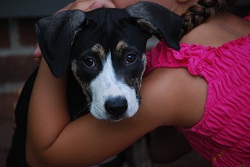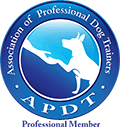Archive CF :: Dogs and Kids
| Though there are many breeds of dogs in the world, there are really only three types of dogs when it comes to children: those who turn inside out with excitement at seeing a child, those who tolerate the presence of children, and those who do not like children. |

|
So, when you are searching for a new dog and you have or plan on having kids in the near future, make sure you're looking for a kid-loving dog. If it is a puppy you seek, then it will be your responsibility to socialize that pup to the many different people (including children), dogs and other animals, and life experiences that will be part of his lifescape. Have your pup get plenty of tasty treats from tikes of all ages, and as you do training with your pup, make sure to include children in this process so that your pup learns that kids are as relevant to his life as adults are.
In the home, there need to be rules so that everyone will enjoy a safe, peaceful coexistence.
- You should never leave your dog alone with young children, no matter how much you trust your kid-loving dog. Accidents can happen in the blink of an eye.
- Your dog should have a designated safe place, like a crate or private room. Children should understand that when the dog goes to this spot, he should be left alone.
- Young kids should be respectful of dogs and what they're expressing through body language; educate your child about dog body language and stress signals.
- Teach your child how to pet a dog gently. He should not pinch or pull on ears or tails, nor should he grab fistfuls of fur. If you know that your child tends to be rough, teach him on a stuffed dog first before introducing him to a real dog.
- Teach your child to wake the sleeping dog by talking to him before touching him. Startling him out of a deep sleep could result in his being defensive.
- As dogs age, they become less tolerant and more prone to pain- or startle-induced reactions. Have frequent vet appointments to make sure that your dog is healthy and pain-free.
Meet Dogs on the Street
You must also teach your children how to behave with unknown dogs on the street.
- Your child should not pet unknown dogs without your permission and then the permission of the owner and the dog -- by asking the dog to come forward to greet your child rather than your child going towards the dog. This is the rule even if his tail is wagging! If the dog does not come forward when invited, then he does not want to socialize and he must be left alone.
- If the dog is open to the interaction, your child should slowly offer his closed fist for a sniff of introduction. A dog may confuse a child's fingers for a treat, a mistake less likely to happen with an offered fist.
- Some dogs may startle when first touched on the back, so first contact is best done by scratching the side of the dog's neck, which does not involve the child's hand coming over the dog's head and does not put the child face-to-face with the dog.
- Teach your child how to pet a dog gently. He should not pinch or pull on ears or tails, nor should he grab fistfuls of fur. If you know that your child tends to be rough, teach him on a stuffed dog first before introducing him to a real dog.
- Avoid dogs that are: in cars, behind fences, or tied up, are eating or sleeping, are near a toy or bone, or are caring for a litter of puppies. Also instruct your child to never tease a dog never to approach a loose dog.
- If a dog growls or gives chases, running or screaming can provoke a predatory "chase" response from the dog. Instead, teach your child to be a tree -- by standing still with legs together, hands clasped in front and looking down at their feet, and they should remain that way quietly until the dog loses interest.
- If a dog knocks your child down, teach him to be a log -- to roll in a ball with fists and arms protecting head and neck, and to remain that way quietly until the dog loses interest.
Dogs and children can share very meaningful relationships. Children who learn to respect, love and empathize with animals will carry these lessons with them into adulthood. All that is required is a thoughtful education on the part of both the children and the dogs to make this a reality.




